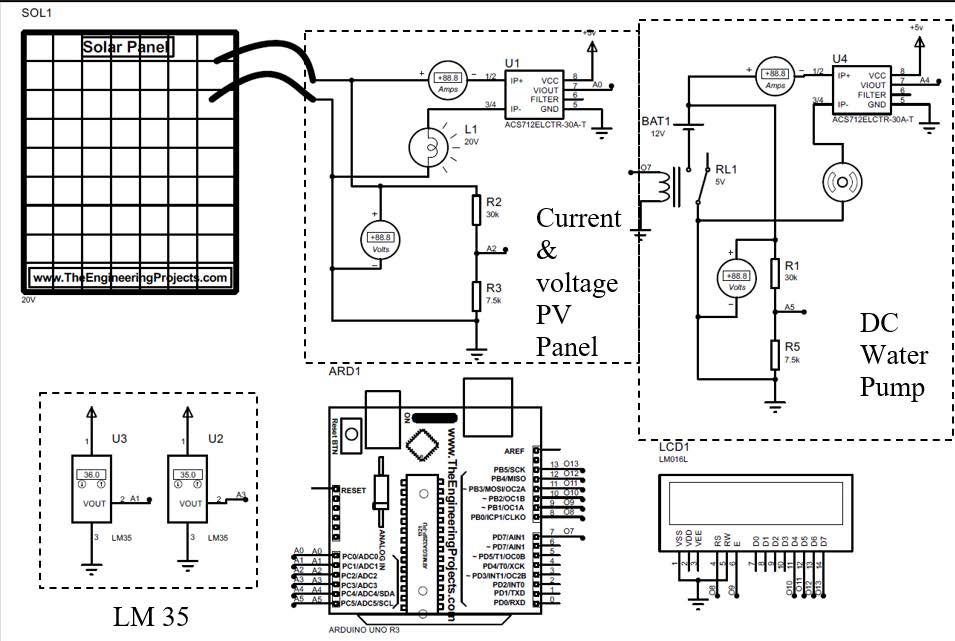The Development of Hybrid Cooling Photovoltaic Panel by using Active and Passive Cooling System
DOI:
https://doi.org/10.37934/cfdl.16.5.107120Keywords:
Electrical performance, hybrid cooling, hydrogels, photovoltaic panel, water sprinklerAbstract
Photovoltaic (PV) panel are crucial in the conversion of solar irradiance into electrical energy. However, the efficiency of PV panel is indirectly influenced by the surface temperature of the panels. According to typical PV module standards, the effect of panel temperature on efficiency is -0.47 %/°C, which indicates that a rise of 1°C reduces the PV panel's efficiency by 0.47 %. The efficiency of the PV panel achieves its maximum value when the panel temperature reaches 25 ℃, which is the standard test condition (STC). Moreover, a high working temperature can also reduce the lifetime of the PV panel. Based on the limitations that have been highlighted above, this project aims to design and develop a hybrid cooling PV panel by using active and passive cooling system with Arduino UNO R3. In this project, 100 W monocrystalline photovoltaic panel has been selected to analyze the result before and after installation of hybrid cooling system. Active cooling system is a water sprinkler system which is applied in front of the PV panel. Meanwhile, the passive cooling system is a combination of hydrogel beads and the heat-sink cooling system which will be installed behind the PV panel. In result, the average power output of PV panel without cooling was 30.59 W while the average power output of PV panel with hybrid cooling was 34.66 W. Moreover, the average power increased due to cooling was 13.31 %. In a nutshell, the proposed project has the ability to develop a hybrid cooling system to improve the performance and efficiency of the PV panel in order to increase the power output of the panel.
Downloads
References
O. G. Rickric, “Hybrid Cooling System for Solar PV Panel,” Int. J. Emerg. Trends Eng. Res., vol. 8, no. 8, pp. 4079–4083, 2020, https://doi.org/10.30534/ijeter/2020/08882020
Jun, Yong-Joon, Kyung-Soon Park, and Young-Hak Song. "A study on the structure of Solar/Photovoltaic Hybrid system for the purpose of preventing overheat and improving the system performance." Solar Energy 230 (2021): 470-484. https://doi.org/10.1016/j.solener.2021.10.019
Ho, S. M., S. N. Ng, and M. A. Munaaim. "Disposal method of crystalline silicon photovoltaic panels: A case studies in malaysia." Asian Journal of Chemistry 33, no. 6 (2021): 1215-1221. https://doi.org/10.14233/ajchem.2021.23105
A. Babawuya and A. O. Ibrahim, “Design Analysis Of Water-Cooled Solar Panel System,” no. August, 2021.
Al-Wajih, Yousif Ahmed, Muhammad Faizan Mysorewala, Ahmed Abdulrahman Mohammed, and Shehab Mostafa. "Improving the Performance of Solar Panels by Automated Water Cooling System and IoT." In 2020 First International Conference of Smart Systems and Emerging Technologies (SMARTTECH), pp. 134-137. IEEE, 2020. https://doi.org/10.1109/SMART-TECH49988.2020.00042
Mandadapu, Usha, Victor Vedanayakam, and K. Thyagarajan. "Effect of temperature and irradiance on the electrical performance of a pv module." International Journal of Advanced Research 5, no. 7 (2017): 2018-2027. https://doi.org/10.21474/IJAR01/3720
Ogbulezie, Julie C., Armstrong O. Njok, Manoj Kumar Panjwani, and Suresh K. Panjwani. "The impact of high temperature and irradiance source on the efficiency of polycrystalline photovoltaic panel in a controlled environment." International Journal of Electrical and Computer Engineering 10, no. 4 (2020): 3942. https://doi.org/10.11591/ijece.v10i4.pp3942-3947
Huot, Mardy, Laveet Kumar, Jeyraj Selvaraj, Md Hasanuzzaman, and Nasrudin Abd Rahim. "Performance investigation of tempered glass-based monocrystalline and polycrystalline solar photovoltaic panels." International Journal of Photoenergy 2021 (2021): 1-8. https://doi.org/10.1155/2021/2335805
Kasim, Naseer K., Nibras M. Obaid, Hatim G. Abood, Raed Abed Mahdi, and Ali Mohmood Humada. "Experimental study for the effect of dust cleaning on the performance of grid-tied photovoltaic solar systems." Int. J. Electr. Comput. Eng 11, no. 1 (2021): 74-83. https://doi.org/10.11591/ijece.v11i1.pp74-83
Wu, Zuyu, Zhongning Zhou, and Mohammed Alkahtani. "Time-effective dust deposition analysis of PV modules based on finite element simulation for candidate site determination." Ieee Access 8 (2020): 65137-65147. https://doi.org/10.1109/ACCESS.2020.2985158
Ahmad, Emy Zairah, Kamaruzzaman Sopian, Adnan Ibrahim, Chin Kim Gan, and Mohd Suffian Ab Razak. "Experimental investigation of passively cooled photovoltaic modules on the power output performance." International Journal of Power Electronics and Drive Systems 13, no. 1 (2022): 520. https://doi.org/10.11591/ijpeds.v13.i1.pp520-527
Karellas, Sotirios, Tryfon C. Roumpedakis, Nikolaos Tzouganatos, and Konstantinos Braimakis. Solar cooling technologies. CRC Press, 2018. https://doi.org/10.1201/9781315163178
Abdo, Saber, Hind Saidani-Scott, Jorge Benedi, and M. A. Abdelrahman. "Hydrogels beads for cooling solar panels: Experimental study." Renewable Energy 153 (2020): 777-786. https://doi.org/10.1016/j.renene.2020.02.057
Rakino, Sunarno A., S. Suherman, S. Hasan, and A. H. Rambe. "A passive cooling system for increasing efficiency of solar panel output." In Journal of Physics: Conference Series, vol. 1373, no. 1, p. 012017. IOP Publishing, 2019. https://doi.org/10.1088/1742-6596/1373/1/012017
Olawole, O. C., E. S. Joel, O. F. Olawole, U. I. Ikono, C. Moses, S. O. Oyedepo, D. K. De et al., "Innovative methods of cooling solar panel: A concise review." In Journal of Physics: Conference Series, vol. 1299, no. 1, p. 012020. IOP Publishing, 2019. https://doi.org/10.1088/1742-6596/1299/1/012020
Yang, Ray-Yeng, and Sheng-Hung Yu. "A Study on a Floating Solar Energy System Applied in an Intertidal Zone." Energies 14, no. 22 (2021): 7789. https://doi.org/10.3390/en14227789
Alktranee, Mohammed, and Péter Bencs. "Simulation study of the photovoltaic panel under different operation conditions." ACTA IMEKO 10, no. 4 (2021): 62-66. https://doi.org/10.21014/acta_imeko.v10i4.1111
Mohammed, Ahmed Hasan, Ghanim Thiab Hasan, and Kamil Jadu Ali. "Numerical analysis of the photovoltaic system inspection with active cooling." International Journal of Electrical and Computer Engineering (IJECE) 11, no. 4 (2021): 2779-2789. https://doi.org/10.11591/ijece.v11i4.pp2779-2789
Kiwan, Suhil M., and Ali M. Khlefat. "Thermal cooling of photovoltaic panels using porous material." Case Studies in Thermal Engineering 24 (2021): 100837. https://doi.org/10.1016/j.csite.2020.100837
King, Marcus, Dacheng Li, Mark Dooner, Saikat Ghosh, Jatindra Nath Roy, Chandan Chakraborty, and Jihong Wang. "Mathematical modelling of a system for solar PV efficiency improvement using compressed air for panel cleaning and cooling." Energies 14, no. 14 (2021): 4072. https://doi.org/10.3390/en14144072




























